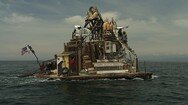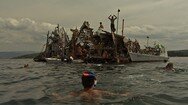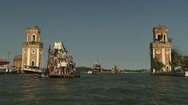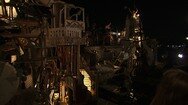Swimming Cities
A group of American artists made the impossible possible: on three rafts built from trash and scrap, they journeyed from Slovenia to Venice. They crossed the Adriatic Sea to reach their destination and conquer the Venice Biennale.
The Swimming Cities of Serenissima
Caledonia Dance Curry, whose artist's name is Swoon, got the inspiration for her project "The Swimming Cities of Serenissima" while on her first visit to Venice. The Italian city, which appears to have simply grown out of the sea and carries the nickname of Serenissima, not only gave the artist the title of her project but also inspired the route of her most ambitious raft project.
But before the 30-head crew rafted from Slovenia to Venice, there were several test runs in the form of other raft projects in the USA. Swoon's series of raft projects began with the "Miss Rockaway Armada" in 2006. Here, too, the rafts were constructed mostly from trash collected and transformed into functional works of art. The underlying concept is the recycling of supposedly useless materials. Virtually all the artists involved are part of the dumpster-diving movement, which involves the searching of dumpsters for usable food. In both cases, it comes down to exploiting the elbowroom between wasteful consumption and basic sustenance. Thus, the art project concerns a politically ambitious movement that, in turn, also draws upon the creative and productive abilities of each individual involved in an alternative form. The crew members contribute both manual skills as well as artistic ability.
Following several generations of raft projects, Swoon initiated the most elaborate of the projects in 2009 with the "Swimming Cities of Serenissima": several containers filled with parts of existing rafts as well as additional recyclable garbage were shipped from New York to Europe. Following several months of preparation by the crew members, a multi-week construction process was undertaken on the Slovenian coast. Even the motors of the rafts were cobbled together by hand from collected car parts. The final constructions are functional, but they tend to be more beautiful than practical; there is a kitchenette, for example, but sleeping places are somewhat scarce. The crew members sleep where they find the space – on the roofs, on the floors, in the lifeboats or in the given port.
After being given the authorization by the Slovenian Coast Guard, the troop undertook their three-week trip to Venice. And although Swoon did not have an invitation to participate in the Biennale, the raft project and participating artists met a positive response from the international audience. Anyone interested could enter the rafts and admire the artifacts collected along the way in the so-called "Cabinet of Curiosities."
But the journey of the rafts did not end in Venice. In Haiti, in full accordance to the artist's principles, they found a new purpose in the form of a raft city of permanent accommodations that is still in use today. And the adventure has also not yet ended for the "maritime artists": for their new project, which is entitled the "Swimming Cities of the Ocean of Blood," they travelled to India in 2011 and, literally, have since brought local artists and artisans there onboard.
Become an online citizen







